| Listing 1 - 10 of 61 | << page >> |
Sort by
|
Book
Year: 2001 Publisher: Porto Alegre: EDIPUCRS,
Abstract | Keywords | Export | Availability | Bookmark
 Loading...
Loading...Choose an application
- Reference Manager
- EndNote
- RefWorks (Direct export to RefWorks)
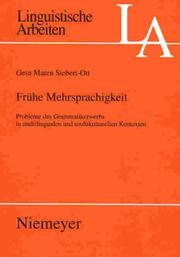
ISBN: 3484304405 Year: 2001 Publisher: Tübingen Max Niemeyer Verlag
Abstract | Keywords | Export | Availability | Bookmark
 Loading...
Loading...Choose an application
- Reference Manager
- EndNote
- RefWorks (Direct export to RefWorks)
Book
Year: 2001 Publisher: Saint-Ghislain Centre international audio-visuel d'études et de recherches
Abstract | Keywords | Export | Availability | Bookmark
 Loading...
Loading...Choose an application
- Reference Manager
- EndNote
- RefWorks (Direct export to RefWorks)
Book
ISBN: 2749219833 Year: 2001 Publisher: Ramonville-Saint-Agne, France : Érès,
Abstract | Keywords | Export | Availability | Bookmark
 Loading...
Loading...Choose an application
- Reference Manager
- EndNote
- RefWorks (Direct export to RefWorks)
De la bouche cousue des enfants mutiques à la bouche vide ou parfois trop pleine des enfants autistes, bouche souffrante, abandonnée, meurtrie, les mots s'échappent, explosent ou restent prisonniers. Cette bouche-carrefour où parole et oralité s'entrecroisent, ne permet-elle pas de considérer l'orthophonie comme un " métier de bouche " ? Non pas dans une réduction opératoire du langage aux seuls organes phonateurs, mais dans la dimension pulsionnelle du plaisir de parler, un métier où les sons, les mots, la langue deviennent le matériau (fait de quatre étoffes indissociables : corps, rythme, parole, musique) à concasser, mâcher, s'approprier, sur un fond de gourmandise des mots que le soignant va tenter de partager avec ses petits patients en difficulté de langage et de relation. Créations langagières, jeux de " mots laids ", erreurs fécondes rythment ici le propos clinique, conforté par un récit de fiction qui vient mettre une distance aux épreuves de la vie, fondement de la structure affective, langagière, psychomotrice et cognitive de l'enfant. Orthophoniste, musicothérapeute, Jacqueline Maqueda travaille depuis une trentaine d'années au sein de l'équipe de pédopsychiatrie du secteur de Villeurbanne, à l'ITTAC (Institut de traitements des troubles de l'affectivité et de la cognition) auprès d'enfants névrotiques, psychotiques et autistes. Elle intervient également à l'atelier sonore thérapeutique du au CHS du Vinatier (Lyon) auprès d'adultes psychotiques. Depuis 1989, elle est chargée d'enseignement en orthophonie à l'université Lyon I - Claude Bernard. Elle collabore depuis 1992 à l'ONG Handicap international en tant que consultante dans les programmes concernant la petite enfance, le soin précoce, l'autisme ainsi que les médiations thérapeutiques.
Book
ISBN: 0939791943 9780939791941 Year: 2001 Publisher: Alexandria (Va.): TESOL,
Abstract | Keywords | Export | Availability | Bookmark
 Loading...
Loading...Choose an application
- Reference Manager
- EndNote
- RefWorks (Direct export to RefWorks)
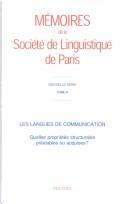
ISBN: 9042911190 2877236307 9789042911192 Year: 2001 Volume: 11 Publisher: Louvain-la-Neuve Peeters
Abstract | Keywords | Export | Availability | Bookmark
 Loading...
Loading...Choose an application
- Reference Manager
- EndNote
- RefWorks (Direct export to RefWorks)
Language acquisition. --- Structural linguistics. --- Multilingualism. --- Multiculturalism.
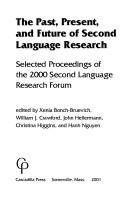
ISBN: 9781574730500 1574730509 Year: 2001 Publisher: Somerville: Cascadilla press,
Abstract | Keywords | Export | Availability | Bookmark
 Loading...
Loading...Choose an application
- Reference Manager
- EndNote
- RefWorks (Direct export to RefWorks)
Book
Year: 2001 Publisher: Washington, DC : ERIC Clearinghouse on Languages and Linguistics,
Abstract | Keywords | Export | Availability | Bookmark
 Loading...
Loading...Choose an application
- Reference Manager
- EndNote
- RefWorks (Direct export to RefWorks)
Communicative competence. --- Lexical grammar. --- Second language acquisition.
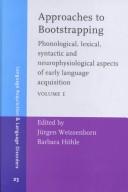
ISBN: 9027224919 9027224927 1556199937 9786612162527 1282162527 902729822X 1556199929 9786612162534 1282162535 9027298238 9789027298232 9781282162532 9781556199929 9789027298225 9781282162525 Year: 2001 Publisher: Amsterdam Benjamins
Abstract | Keywords | Export | Availability | Bookmark
 Loading...
Loading...Choose an application
- Reference Manager
- EndNote
- RefWorks (Direct export to RefWorks)
What features of brain processing and neural development support linguistic development in young children? To what extent is the profile and timing of linguistic development in young children determined by a pre-ordained genetic programme? Does the environment play a crucial role in determining the patterns of change observed in children growing up? Recent experimental, neuro-imaging and computational studies of developmental change in children promise to contribute to a deeper understanding of how the brain gets wired up for language. The multi-disciplinary perspectives of cognitive neuroscience, experimental psycholinguistics and neural network modelling are brought to bear on four distinct areas in the study of language acquisition: early speech perception, word recognition, word learning and the acquisition of grammatical inflections. Each area demonstrates how linguistic development can be driven by the interaction of general learning mechanisms, highly sensitive to particular statistical regularities in the input, with a richly structured environment. This interaction provides the necessary ingredients for the emergence of linguistic representations that support mature language processing. Similar epigenetic principles, guiding the emergence of linguistic structure, apply to all these domains, offering insights into the precocity of young infant's sensitivity to speech contrasts as well as to the complexities of the problem facing the young child learning the Arabic plural.
Psycholinguistics --- Language acquisition. --- Language awareness in children. --- Children --- Language acquisition --- Interpersonal communication in children --- Language
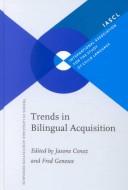
ISBN: 1282159992 9786612159992 902729481X 9789027294814 9781588110992 1588110990 9789027234711 902723471X 1588110990 902723471X Year: 2001 Publisher: Amsterdam Philadelphia J. Benjamins
Abstract | Keywords | Export | Availability | Bookmark
 Loading...
Loading...Choose an application
- Reference Manager
- EndNote
- RefWorks (Direct export to RefWorks)
The chapters in this volume provide the first comprehensive overview of trends in research on early phonological, lexical, syntactic and pragmatic development in children acquiring two (or more) languages simultaneously. Ongoing as well as emerging issues are examined and discussed by leading researchers in the field. Collectively, these studies extend our knowledge of bilingual acquisition and broaden our understanding of the child's ability to acquire and use language. This volume is of interest to researchers working on language acquisition by monolingual and bilingual children, graduate students of psychology, linguistics and communication sciences, and researchers and professionals concerned with the diagnosis and treatment of bilingual children with language impairment.
| Listing 1 - 10 of 61 | << page >> |
Sort by
|

 Search
Search Feedback
Feedback About UniCat
About UniCat  Help
Help News
News